
International Journal of Emergency Medicine
Scope & Guideline
Connecting experts to transform emergency care.
Introduction
Aims and Scopes
- Emergency Medicine Practices:
The journal covers a wide range of topics related to emergency medicine practices, including but not limited to trauma management, resuscitation techniques, and diagnostic approaches. It emphasizes evidence-based practices that improve patient outcomes in emergency settings. - Public Health and Epidemiology:
Research related to public health issues, epidemiology of diseases, and healthcare delivery systems is a core focus. The journal addresses emergency medicine's role in managing public health crises, including the impact of infectious diseases and environmental factors. - Innovative Educational Strategies:
The journal promotes innovative educational methodologies for training healthcare professionals in emergency medicine. This includes simulation-based training, assessment tools, and curriculum development aimed at enhancing the competencies of practitioners. - Technology and Emergency Care:
The integration of technology in emergency medicine, such as point-of-care ultrasound, telemedicine, and artificial intelligence, is a key area of exploration. The journal highlights studies that assess the effectiveness and implementation of these technologies in clinical practice. - Case Reports and Clinical Insights:
The journal encourages the publication of case reports that provide insights into unique or complex clinical scenarios encountered in emergency medicine. This includes rare diseases, unusual presentations, and lessons learned from clinical practice.
Trending and Emerging
- Impact of COVID-19 on Emergency Medicine:
Research exploring the implications of the COVID-19 pandemic on emergency medicine practices, patient outcomes, and healthcare systems has surged. This includes studies on changes in patient demographics, management strategies, and the adaptation of emergency services during the pandemic. - Mental Health Emergencies:
There is an increasing focus on mental health-related emergencies, particularly in the context of the COVID-19 pandemic's psychological impact. This theme encompasses the management of psychiatric crises in emergency settings and the integration of mental health services in emergency care. - Telemedicine and Remote Care:
The rise of telemedicine as a vital tool in emergency care has become a significant area of interest. Research is focusing on the effectiveness, patient satisfaction, and outcomes associated with virtual consultations and remote monitoring in emergency settings. - Advanced Diagnostic Techniques:
Emerging studies on advanced diagnostic tools, such as point-of-care ultrasound and machine learning applications in triage and diagnosis, are trending. This reflects a shift towards enhancing diagnostic accuracy and efficiency in emergency medicine. - Global Health Initiatives:
The journal is increasingly publishing research on global health initiatives and emergency care in low-resource settings. This includes studies on the development and implementation of emergency medical systems and training programs in developing countries.
Declining or Waning
- Traditional Trauma Cases:
There appears to be a declining emphasis on traditional trauma case reports as the field evolves to cover more complex and multifaceted emergencies. As emergency medicine expands, the focus has shifted towards systemic approaches and public health implications. - Basic Life Support Training:
Research specifically focused on basic life support training has decreased, possibly due to the widespread adoption and standardization of these protocols in emergency care. The journal is now more inclined to explore advanced resuscitation techniques and their implications. - Single-Country Studies:
There is a noticeable reduction in studies that focus solely on emergency medicine practices within a single country. Instead, there is a growing trend towards multicenter and international studies that provide broader insights and comparative analyses. - Historical Perspectives:
The publication of historical analyses of emergency medicine practices seems to be waning, as contemporary issues and challenges take precedence in discussions about the future of emergency care.
Similar Journals

Journal of Emergency Medicine Case Reports
Elevating Emergency Medicine with Innovative Case StudiesJournal of Emergency Medicine Case Reports, published by the Emergency Medicine Physicians Association of Turkey, stands as a significant contribution to the field of emergency medicine. With an ISSN of 2149-9934, this journal provides a platform for emerging case reports that highlight innovative practices, critical interventions, and unique challenges faced in emergency medical settings. The absence of an open access model may raise challenges for some readers; however, the journal compensates with rigorous peer review and a focus on high-quality clinical insights that serve both academic and practical purposes. Aiming to enhance the global understanding of emergency scenarios, the journal welcomes submissions from researchers and practitioners that contribute to the continuous improvement of emergency care, ultimately aiming to foster knowledge-sharing and collaboration within this vital medical domain.
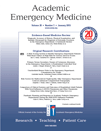
ACADEMIC EMERGENCY MEDICINE
Exploring Innovations in Emergency Medical PracticeACADEMIC EMERGENCY MEDICINE, published by Wiley, stands as a leading journal in the field of emergency medicine, distinguished by its impressive rankings, including Q1 categories in both Emergency Medicine and Miscellaneous Medicine. With an ISSN of 1069-6563 and an E-ISSN of 1553-2712, the journal covers a broad array of topics relevant to emergency medicine, advancing research from its inception in 1994 up to 2024. Ranked #8 out of 109 in its category, this journal sits in the 93rd percentile according to Scopus, underscoring its significance and influence within the academic community. Although it does not currently offer open access options, its rigorous peer-review process and comprehensive publication standards ensure that only the highest quality research reaches its readership. Aimed primarily at researchers, practitioners, and students in the field, ACADEMIC EMERGENCY MEDICINE serves as an essential resource for those seeking to enhance their understanding and practice of emergency care, making significant contributions to both theory and clinical applications in the field.
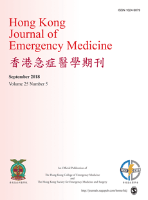
Hong Kong Journal of Emergency Medicine
Illuminating the Path in Emergency MedicineThe Hong Kong Journal of Emergency Medicine, published by WILEY, stands as a vital resource in the field of Emergency Medicine since its inception in 2004. With a commitment to advancing clinical practice and research, this open access journal—transitioned to open access in 2018—facilitates the dissemination of crucial knowledge among healthcare professionals and researchers, fostering a collaborative environment for addressing urgent medical challenges. The journal boasts an impressive impact factor and holds a Q2 ranking in the Emergency Medicine category for 2023, reflecting its significance and influence within the academic community. Located in Hong Kong, this journal aims to explore a broad spectrum of topics related to emergency and critical care, making it an essential publication for those seeking to enhance their understanding and practice in this fast-evolving field. Accessible through ISSN: 1024-9079 and E-ISSN: 2309-5407, it promises to be an invaluable asset for researchers, practitioners, and students alike.
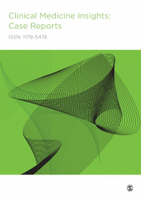
Clinical Medicine Insights-Case Reports
Bridging gaps in healthcare with detailed case reports.Clinical Medicine Insights - Case Reports, published by SAGE Publications Ltd, is a premier Open Access journal dedicated to advancing the understanding of clinical medicine through detailed case reports. Since its inception in 2008, this journal has provided a vital platform for the dissemination of innovative medical findings and practical insights from the global clinical community. Operating from New Zealand, the journal holds a Q4 rating in the Medicine (miscellaneous) category as of 2023, and ranks #344 out of 636 in the general medicine field according to Scopus, highlighting its commitment to contributing valuable knowledge to healthcare practices. With an objective to foster collaboration and knowledge sharing among researchers and healthcare professionals, Clinical Medicine Insights - Case Reports serves as an essential resource for those seeking to expand their understanding of clinical phenomena through real-world experiences and outcomes. By featuring diverse case studies, the journal enables its readers to engage with significant clinical challenges and innovative solutions, making it an indispensable resource for students, professionals, and researchers alike.
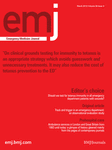
EMERGENCY MEDICINE JOURNAL
Connecting Professionals with Essential Medical InsightsEmergency Medicine Journal, published by BMJ Publishing Group in the United Kingdom, stands as a preeminent resource within the realm of emergency and critical care medicine. ISSN 1472-0205 and E-ISSN 1472-0213 reflect its commitment to accessible research, emphasizing open access options to enhance the dissemination of vital medical insights. The journal boasts an impressive categorization, achieving a Q1 ranking in Critical Care and Intensive Care Medicine, Emergency Medicine, and miscellaneous Medicine in 2023. With a focus on high-quality peer-reviewed articles, it serves as an essential platform for sharing innovative research and evidence-based practices that enhance patient care in emergency settings. Ranking 23rd in Emergency Medicine, with a commendable 79th percentile in Scopus rankings, it underscores its position as a leading journal among peers, making it indispensable reading for researchers, professionals, and students alike who seek to stay abreast of evolving trends and practices in emergency medicine and critical care.
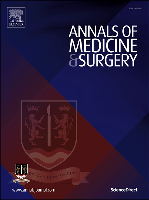
Annals of Medicine and Surgery
Innovative Insights for Healthcare ProfessionalsAnnals of Medicine and Surgery is a reputable multidisciplinary journal published by Lippincott Williams & Wilkins, focusing on a broad range of topics pertinent to both medicine and surgery. With an ISSN of 2049-0801, this journal aims to disseminate innovative research findings and clinical studies that contribute to the advancement of medical and surgical practices. Since its inception in 2012, it has established itself within the academic community, achieving a Q3 ranking in both the Medicine (miscellaneous) and Surgery categories for 2022. Despite its coverage being discontinued in Scopus, the journal continues to receive attention, ranked in the 45th percentile for its fields, illustrating its growing influence. Researchers, healthcare professionals, and students will find in this journal an invaluable resource for enhancing their understanding and staying updated with evolving medical and surgical landscapes. Access options are currently managed through institutional subscriptions, ensuring the dissemination of high-quality research to a diverse audience.
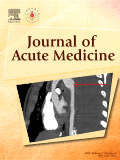
Journal of Acute Medicine
Elevating standards in acute medical practice.Journal of Acute Medicine is a pivotal platform for disseminating cutting-edge research within the fields of Critical Care and Intensive Care Medicine and Emergency Medicine. Published by the Taiwan Society of Emergency Medicine in the Netherlands, this journal serves as a vital resource for healthcare professionals and researchers devoted to advancing acute medical practice. With an ISSN of 2211-5587 and an E-ISSN of 2211-5595, the journal features a collection of high-quality articles that focus on the latest developments and challenges facing emergency healthcare systems. Since its inception in 2011, the journal has achieved a respectable Q3 ranking in both critical care and emergency medicine categories, demonstrating its commitment to scholarly excellence. Although it currently does not operate as an open-access publication, the journal provides a critical forum for exchanging knowledge, fostering collaborations, and enhancing clinical practices, ensuring that it remains an essential read for those involved in acute medical care.
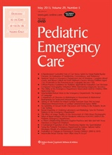
PEDIATRIC EMERGENCY CARE
Innovating Child Health Through Rigorous ResearchPediatric Emergency Care, published by Lippincott Williams & Wilkins, serves as a vital resource within the fields of Emergency Medicine, Pediatrics, and Child Health. Established in 1985, this journal offers a platform for the dissemination of impactful research, offering critical insights for healthcare professionals dedicated to improving emergency care for children. With an impressive impact factor, it ranks in the Q2 category in Emergency Medicine and Pediatrics, highlighting its significance in advancing clinical practices and outcomes. Although not an open-access journal, it provides extensive access options to ensure the research is available to a broad spectrum of readers. The journal's rigorous standards and commitment to excellence make it an essential tool for researchers, practitioners, and students aiming to stay at the forefront of pediatric emergency care advancements.
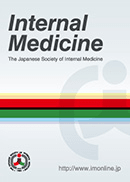
Internal Medicine
Elevating Knowledge in Internal MedicineInternal Medicine is a distinguished peer-reviewed journal published by the Japan Society of Internal Medicine, focusing on the nuanced field of internal medicine. Since its inception in 1974 and with a commitment to advancing medical knowledge, the journal has evolved remarkably, aiming to disseminate high-quality research that contributes to the understanding and treatment of internal diseases. Operating from Tokyo, Japan, it provides an intellectual platform for researchers and clinicians to publish original articles, reviews, and case studies that address various aspects of internal medicine. The journal currently holds a ranking in the Q3 quartile for both Internal Medicine and miscellaneous Medicine categories as of 2023, signifying its growing influence in the medical community. Although not an open-access journal, it remains accessible to a wide audience through institutional subscriptions, enhancing its reach among professionals and students alike. With its commitment to excellence, Internal Medicine serves as an essential resource for those seeking the latest developments and research within this vital medical field.
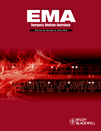
Emergency Medicine Australasia
Enhancing Patient Outcomes Through Collaborative ResearchEmergency Medicine Australasia, published by WILEY, stands as a premier journal in the field of emergency medicine, underlining its significance through its distinguished ranking as Q1 in Emergency Medicine and Q2 in Medicine (miscellaneous) as of 2023. The journal, which has been in circulation since 2004, provides a platform for high-quality research, clinical studies, and reviews that contribute to the advancements in emergency medicine practices. With a Scopus rank of 28 out of 109 in its category, it occupies a notable position within the medical community, boasting a 74th percentile ranking that reflects its impactful contributions to the field. Although it operates primarily on a subscription basis, Emergency Medicine Australasia is essential reading for researchers, practitioners, and students seeking to stay updated on the latest developments and methodologies in emergency care. This journal not only aims to disseminate critical knowledge but also fosters a collaborative environment for sharing innovations that improve patient outcomes and emergency services.